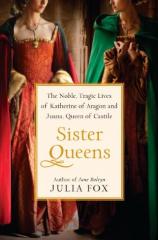Sister Queens: The Noble, Tragic Lives of Katherine of Aragon and Juana, Queen of Castile
Review
Sister Queens: The Noble, Tragic Lives of Katherine of Aragon and Juana, Queen of Castile
The story of Queen Isabella and King Ferdinand’s youngest daughters opens in Granada, with the Spanish defeat of the Moors. Isabella’s Catholic faith is “central to her being, and she did all in her power to ensure that the same was true of her children.”
Juana is the fourth child of Ferdinand and Isabella. Born in 1479, she is a lively and pretty child. Katherine follows in December 1485. Within her family, Katherine is called Catalina. The girls’ older siblings are sisters Isabella and Maria, and brother Juan. The Spanish Monarchs, as Ferdinand and Isabella are known, are determined to use their five children to solidify Spanish interests.
Even as kids, Juana and Katherine understand that their gender has determined their future. At an early age, they are instructed that when they become wives, they should “dedicate their lives to the service of God and act as ambassadors for their homeland.”
"Julia Fox gives an intimate portrait of and a fresh perspective into the lives of Juana and Katherine within the context of their faith, family and fidelity to their Spanish heritage."
Juana is to become the wife of Philip of Burgundy, whom she passionately loves. After his death, she is said to be so profoundly grief-stricken that she keeps his coffin by her side and refuses to allow him to be buried. Betrayed by her father and brother, Juana is determined to be too insane to rule.
Katherine of Aragon’s story is more familiar. As a young teenager, Katherine is brought to England to marry Arthur, Prince of Wales, oldest son of Henry VII. After Arthur’s death, she becomes a widow. Following negotiations between Spain and England, she is married to Arthur’s brother, Henry VIII. After numerous unsuccessful pregnancies, Katherine has a live child, a girl, the future Queen Mary I. Unable to give the king a male heir, Katherine is cast aside by Henry for Anne Boleyn, who subjects the queen to humiliating and scandalous treatment. Katherine’s marriage is annulled after Henry VIII breaks with the Roman Catholic Church and declares himself the head of the Church of England.
In SISTER QUEENS, Julia Fox gives an intimate portrait of and a fresh perspective into the lives of Juana and Katherine within the context of their faith, family and fidelity to their Spanish heritage. Her well-documented book is divided into six main parts: Isabella’s Daughters, Wives, Widows, Sister Queens, The Sky Darkens, and Adversity. The Genealogical Tables of The Tudor Succession and The Family of Katherine and Juana at the beginning are quite helpful. I found myself flipping back and forth to these references as a family member or a monarch was introduced. The color photos in the middle of the text enhanced my reading pleasure, as they helped me visualize the Catholic Monarchs, the queen sisters and other principals mentioned in Fox’s book.
While the narrative is reader-friendly for the most part, it took me much longer than expected to finish the book, most likely due to the many names, dates, locations, facts, details and specifics. But it was well worth the time. Readers who enjoy biographies, especially those interested in European royalty and the impact of the Catholic Church on shaping world history, should enjoy SISTER QUEENS.
Reviewed by Donna Volkenannt on February 16, 2012
Sister Queens: The Noble, Tragic Lives of Katherine of Aragon and Juana, Queen of Castile
- Publication Date: January 31, 2012
- Genres: Biography, History, Nonfiction
- Hardcover: 480 pages
- Publisher: Ballantine Books
- ISBN-10: 0345516044
- ISBN-13: 9780345516046





